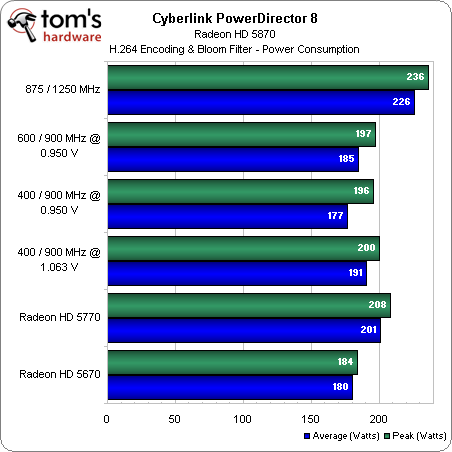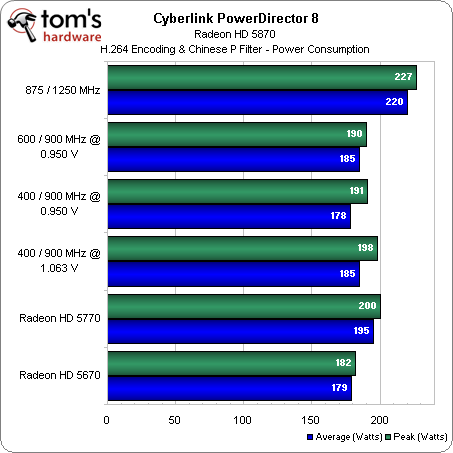Curbing Your GPU's Power Use: Is It Worthwhile?
In many cases, the graphics card is the most power-hungry component in a PC. The enthusiast community is no stranger to CPU tweaking, so why hasn't GPU modification caught on? We're going to see just how much you stand to gain (or lose) from tweaking.
Benchmark Results: Cinebench R11 And PowerDirector 9
Desktop Usage: Cinebench R11
Based on our results, you will not notice any difference in performance between the tested settings. Even at lower clocks, the Radeon HD 5870 still ends up faster than the HD 5770. This just goes to show that, for most desktop applications, you only need a mainstream graphics card like the Radeon HD 5770. The other thing we’d like to point out is that the Radeon HD 5870, operating at lower clocks, is only slightly slower, at least in desktop applications. Now, let's look at the power savings.
We're including average power consumption numbers, in addition to peak power consumption, for the entire test. Running at DXVA clocks, the Radeon HD 5870’s peak power consumption is actually lower than the Radeon HD 5770. The Radeon HD 5770 still proves to be more frugal in average power measurements, thanks to its less complex graphics processor. With lower operating voltages, the Radeon HD 5870 winds up with lower numbers. Even more impressive, the difference is a mere three watts higher than a Radeon HD 5670.
H.264 GPU-Accelerated Encoding And Filters: PowerDirector 8
With hardware-accelerated decoding enabled, these graphics cards run at their respective UVD clocks. For reference, we've also included results without hardware-acceleration with the card running at its maximum clock settings (875/1250 MHz). Hardware-accelerated decoding is enabled at both undervolted settings.
For those interested, we've also included peak and average power consumption numbers here, in addition to total power consumed during the test. The changes we made to the Radeon HD 5870’s BIOS allow it to consume less power than the Radeon HD 5770. This is even more impressive when we consider the fact that the Radeon HD 5770 is also running at UVD clocks (400/900 MHz @ 0.95 V), rather than its maximum clock (850/1200 MHz @ 1.2 V). With the changes, the tweaked Radeon HD 5870 is not that far from the HD 5670, also running at UVD clocks (550/900 MHz @ 1.0 V).
Get Tom's Hardware's best news and in-depth reviews, straight to your inbox.
Current page: Benchmark Results: Cinebench R11 And PowerDirector 9
Prev Page The First Experiment: AMD’s Radeon HD 5870 Next Page Benchmark Results: PowerDVD 9 And Desktop Idle-
I think, considering those people using SLi and crossfire and higher end videocards, they don't really give a gat about how much elec. they are using. They can afford to buy two expensive PCBs, why would they care about extra 5~10 bucks per month? If poeple are focused on lower power consumption, they would go for lower performance components, arent they?Reply
-
anttonij I guess the most important point of this review is that you can lower the cards voltage while running at stock speed. For example I'm running my GTX 460 (stock 675/1800@1.012V) at 777/2070@0.975V or if I wanted to use the stock speeds, I could lower the voltage to 0.875V. I've also lowered the fan speeds to allow the card to run almost silently even at full load.Reply -
Khimera2000 @.@ there is no apple @.@Reply
This is neat though :) I wonder if this article might inspire someone to make an application. Come on open source dont fail me now >. -
Could you do comparison of "the fastest VC" vs "entry level" and then show us how much money we might end up paying each month or day?Reply
-
the_krasno Manufacturers should find a way to implement this automatically, imagine the possibilities!Reply -
wrxchris @OvaCerReply
I have 2 gfx cards pushing 3 displays, but I'm all for saving watts wherever I can. Our society has advanced to the point where sustainability is a very important buzzword that is widely ignored by mainstream media and many corporations, and this ignorance trickles down to the mainstream like Reaganomics. Minuscule reductions such as 30w savings across hundreds of thousands if not millions of users adds up to a significant reduction in carcinogenic emissions and saves valuable resources for future consumption. -
neiroatopelcc So when playing video, you risk your amd card going into uvd mode? What models does that apply to?Reply
I want to know, cause for instance in a raid, I'd sometimes watch video content on another screen while waiting around for whatever there is to wait for. I already lose the crossfire performance because of window mode. I don't want to lose even more.
Does my ancient 4870x2 support uvd? -
jestersage so... for the dual bios HD6900s, I can RBE one bios with my desired settings and just choose which bios to use before I power up my PC? hmmm... interesting.Reply





